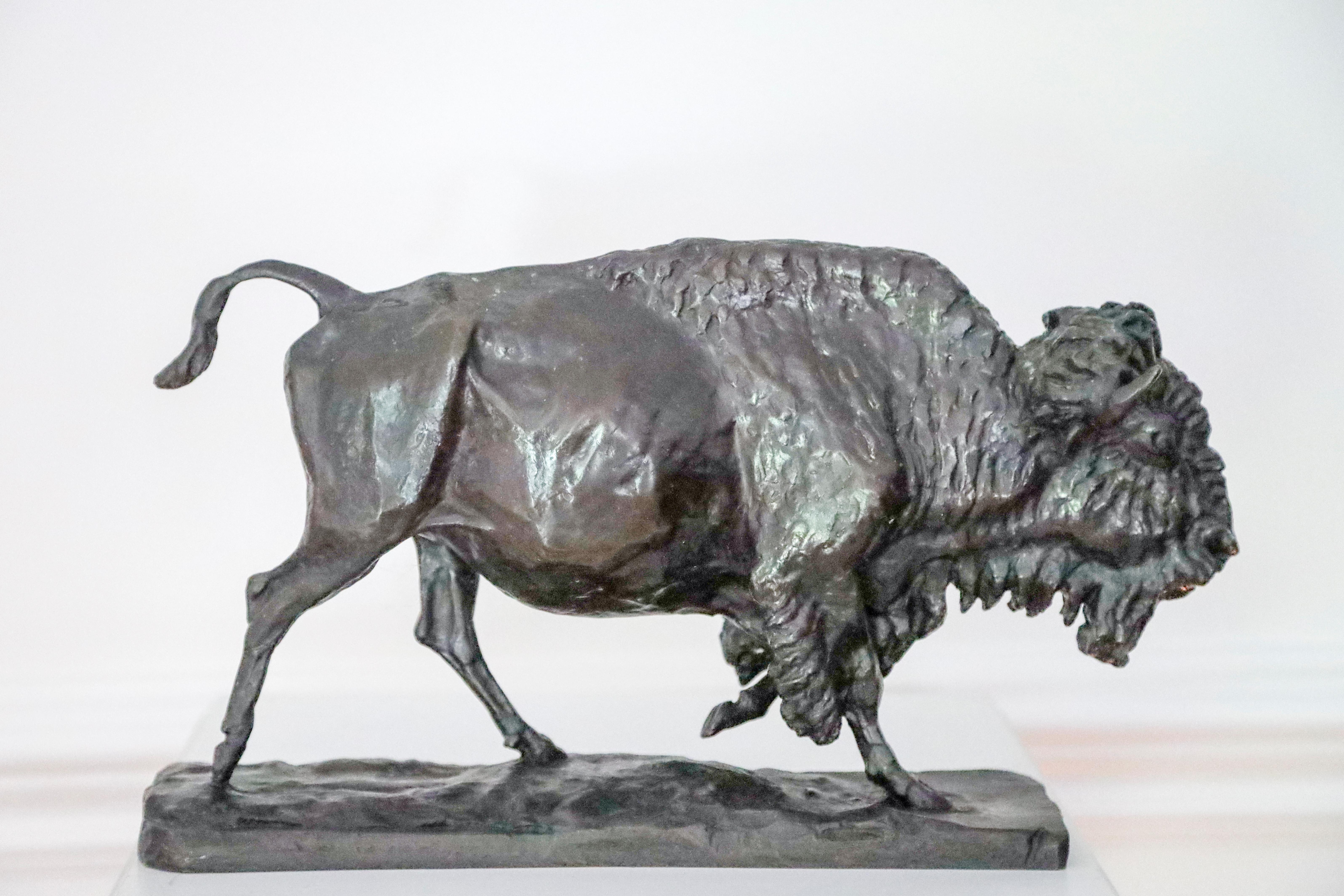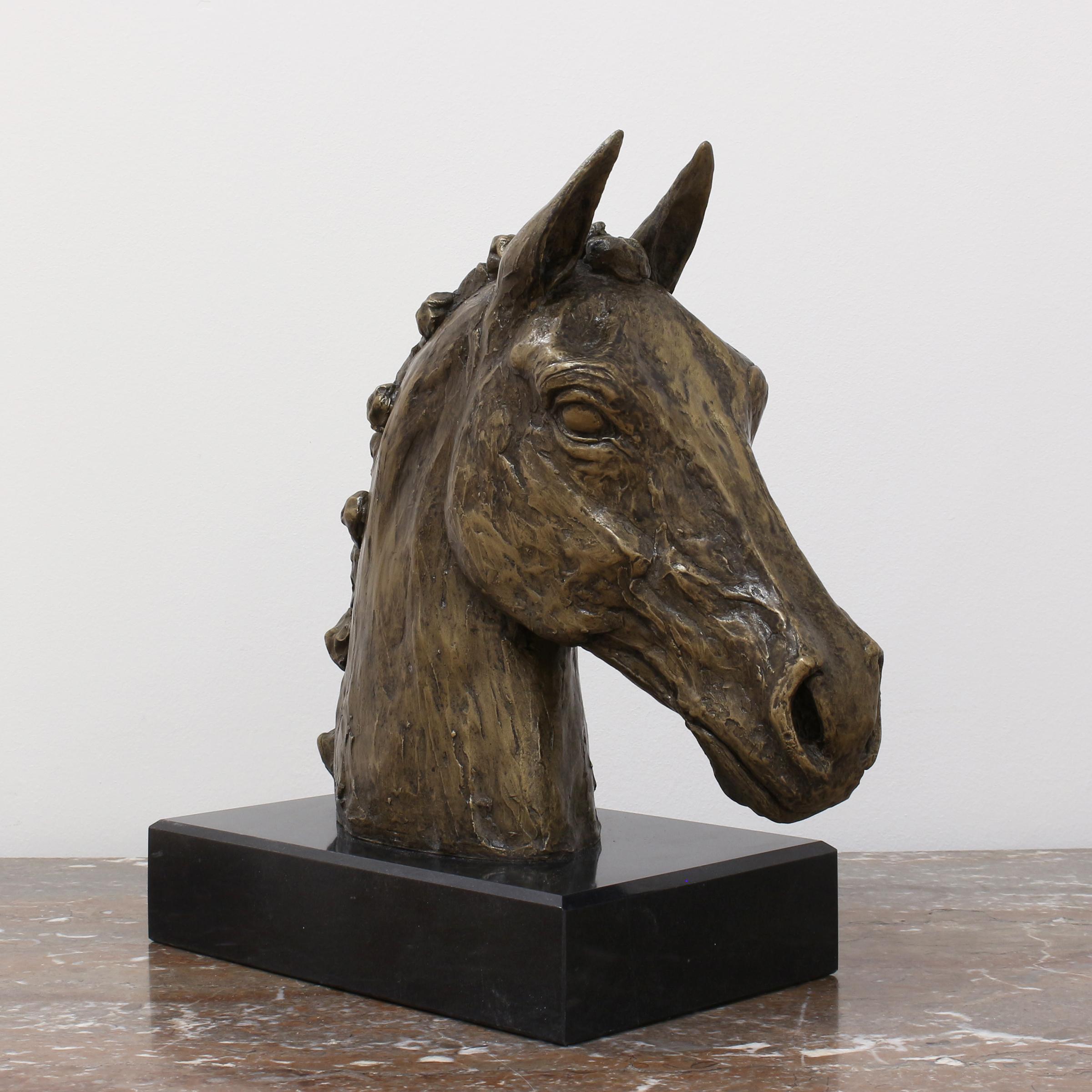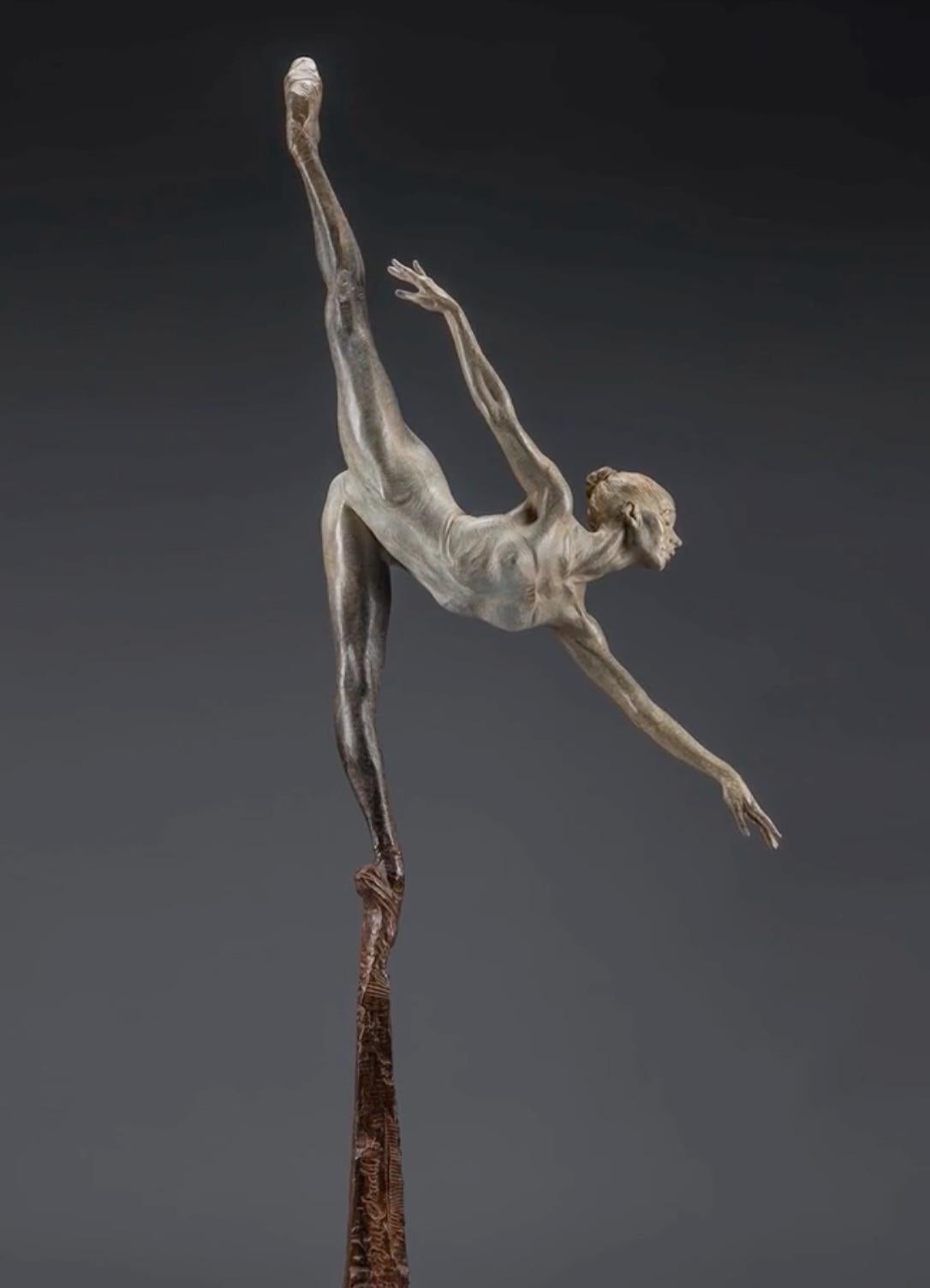Items Similar to Native American Girl with Doll
Want more images or videos?
Request additional images or videos from the seller
1 of 3
Dave PowellNative American Girl with Doll
About the Item
Native American Girl with Doll
By Dave Powell (American, b. 1954)
Signed on Back
17.5" x 8"
Dave Powell is a native son of Montana, in a world of change and transition; few can say they have roots in a single geography that go back four generations. Dave's pedigree in art is just about as deep. He is the son of artists Ace Powell and Nancy McLaughlin Powell. That heritage leads back to the likes of Charlie Russell and Joe De Young, both famous for their abilities to "tell the story" through their art. His father, Ace Powell, was a prolific Western artist whose first childhood paint-box set was a gift from Charlie and Nancy Russell.
Dave became a serious student of art in his mid-teens, and has been a professional artist most of his adult life. Over the years he has worked with Bob Scriver, Ned Jacob and Robert Lougheed. Dave will be the first to give thanks and credit to CAA founder Joe Beeler for his longstanding friendship and guidance over many years.
Because of his vast knowledge of the dress and habits of Western Indians, pioneers and cowboys, Dave is often called upon to provide costumes and props, and to give technical advice about authenticity for films and television. Productions he has worked on include Good Old Boys, Silverado, The Life and Times of Grizzly Adams and Lonesome Dove.
His interests in historic reenactments and rides have taken him all across the West, and these travels have afforded Dave the opportunity for inspiration. While his film work utilizes his experience and observation, his sculptures, paintings and illustrations are born of his imagination.
Dave and his family now reside in central Montana, just a short drive from Charlie Russell's home in Great Falls. There he is constantly inspired by the very buttes and prairies that Russell himself loved and painted.
- Creator:Dave Powell (1954)
- Dimensions:Height: 17.5 in (44.45 cm)Width: 8 in (20.32 cm)
- Medium:
- Movement & Style:
- Period:
- Condition:
- Gallery Location:Missouri, MO
- Reference Number:1stDibs: LU747311880382
About the Seller
5.0
Vetted Seller
These experienced sellers undergo a comprehensive evaluation by our team of in-house experts.
Established in 1970
1stDibs seller since 2017
141 sales on 1stDibs
Typical response time: 22 hours
- ShippingRetrieving quote...Ships From: Missouri, MO
- Return PolicyA return for this item may be initiated within 2 days of delivery.
More From This SellerView All
- 2 Seconds To GoBy Bob ScriverLocated in Missouri, MOBob Scriver (American 1914-1999) "2 Seconds To Go" 1971 Bronze approx. 24" H. x 12W Signed and Titled on the Base Ed. 18/35 sculptor who carried on the realist...Category
1970s American Realist Figurative Sculptures
MaterialsBronze
- Preparing to RideLocated in Missouri, MOPreparing to Ride By. George B. Marks (American, 1923-1983) Signed and Dated Throughout his artistic career, George Marks’s work was always guided by the...Category
1970s American Realist Figurative Sculptures
MaterialsBronze
- The Holdup of the Overland StagecoachBy Gordon PhillipsLocated in Missouri, MOThe Holdup of the Overland Stagecoach By. Gordon Phillips (American, 1927-2011) Initialed and Edition 493/750 Gordon Phillips was born in 1927 in Boone, North Carolina. He studied a...Category
20th Century American Realist Figurative Sculptures
MaterialsMetal
- Native American in CanoeBy Carl KaubaLocated in Missouri, MOCarl Kauba (1865-1922) "Native American in Canoe" Polychrome Bronze Signed approx 5.5 x 10 x 2.75 inches This Austrian sculptor was born in Vienna in 1865. His teachers were Karl Waschmann (1848-1905), known for his ivory sculptures and portrait plaquettes of contemporary celebrities, and Stefan Schwartz (1851-1924), who exhibited in Paris, including the Exposition Universelle of 1900 where he won a gold medal. Kauba's intricate bronzes, imported to the United States between 1895 and 1912, were cast at the Roman Bronze Works. Kauba was part of the nineteenth-century tradition of polychrome bronze sculpture. There were several types of patinas on a single statue: he could render the color of buckskin, variously tinted shirts, blankets, feathers, as well as beaded moccasins. Reportedly, Kauba came to America around 1886. Inspired by the Western tales of German author Karl May, he traveled to the West and made sketches and models. Critics, however, pointed out inaccuracies of costume and other details. For instance, the guns that his "mid-nineteenth-century" figures use are models produced after 1898. Apparently he did all of his works back in Vienna. Besides the variety of color, Kauba's bronzes show a great range of textures and his style is highly naturalistic. The sculptor loved ornament, some of which he rendered with coiled wire for reins, rope and feathers in headdresses. He successfully rendered figures in motion and often executed compositions with more than one figure. Berman (1974) illustrates non-Western subjects by Kaula, such as the pendants Where? and There (ca. 1910), a seated Scottish couple, impressive in the expressions and the details on patterned fabrics of both sitters. Another genre piece is Buster Brown...Category
Early 20th Century Realist Figurative Sculptures
MaterialsBronze
- Study AimBy Carl KaubaLocated in Missouri, MOCarl Kauba "Study Aim" c. 1920 Bronze with Brown Patina Signed approx. 9.5 x 10 x 4 This Austrian sculptor was born in Vienna in 1865. His teachers were Karl Waschmann (1848-1905), known for his ivory sculptures and portrait plaquettes of contemporary celebrities, and Stefan Schwartz (1851-1924), who exhibited in Paris, including the Exposition Universelle of 1900 where he won a gold medal. Kauba's intricate bronzes, imported to the United States between 1895 and 1912, were cast at the Roman Bronze Works. Kauba was part of the nineteenth-century tradition of polychrome bronze sculpture. There were several types of patinas on a single statue: he could render the color of buckskin, variously tinted shirts, blankets, feathers, as well as beaded moccasins. Reportedly, Kauba came to America around 1886. Inspired by the Western tales of German author Karl May, he traveled to the West and made sketches and models. Critics, however, pointed out inaccuracies of costume and other details. For instance, the guns that his "mid-nineteenth-century" figures use are models produced after 1898. Apparently he did all of his works back in Vienna. Besides the variety of color, Kauba's bronzes show a great range of textures and his style is highly naturalistic. The sculptor loved ornament, some of which he rendered with coiled wire for reins, rope and feathers in headdresses. He successfully rendered figures in motion and often executed compositions with more than one figure. Berman (1974) illustrates non-Western subjects by Kaula, such as the pendants Where? and There (ca. 1910), a seated Scottish couple, impressive in the expressions and the details on patterned fabrics of both sitters. Another genre piece is Buster Brown...Category
Early 20th Century Realist Figurative Sculptures
MaterialsBronze
- La CothurneBy Agathon LéonardLocated in Missouri, MO"La Cothurne" 1901 Gilt Bronze Approx 21.5" High (to raised hand) Signed and Dated Foundry Mark "Susse Freres" Originally modeled in white biscuit porcelain this Greek dancer is a from a set of eight created for a dining table. They were immediately successful when they were exhibited in the Sevres pavilion at the 1900 Exhibition. Individual figures could be ordered and "La Cothurne" proved the most popular. Their success led to the firm of Susse buying the right to cast versions in metal. Agathon Leonard (1841-1923) is one of the well-known French Art Nouveau sculptors. Born in Lille in 1841, he first studied there before moving to Paris where he studied at the Ecole des Beaux Arts under Eugene Delaplanche. He gained recognition at the annual Expositiones Universelles, winning a Silver Medal there in 1889 and gold in 1900. His most important piece, Jeu L'echarpe, was the best known series of Sevres production at the turn of the century and sold out at the 1900 Expo in Paris and later was given as a gift by the French Gov't to Nicholas II at the Hermitage. His bronzes were cast at the Susse Freres Editeurs Foundry. He worked also in marble, quartz and ivory. He also produced Art Nouveau medallions...Category
Early 1900s Art Nouveau Figurative Sculptures
MaterialsBronze
You May Also Like
- Buffalo or Bison in bronze by Charles RumseyBy Charles Cary RumseyLocated in Brookville, NYBuffalo Cow by Charles Rumsey, a bronze sculpture that dates C.1910 and may be part of the preparation for the Manhattan Brie Frieze executed in 1916. ...Category
1910s American Realist Figurative Sculptures
MaterialsBronze
- DOREATHABy W Stanley ProctorLocated in Tallahassee, FLA sweet woman who loved people (especially babies), animals and honeysuckle.Category
20th Century American Realist Figurative Sculptures
MaterialsBronze
- Farmer Han and the Farmer's WifeBy Dee ClementsLocated in Loveland, COFarmer Han and the Farmer's Wife by Dee Clements Figurative Bronze Pair. Excellent condition. Has been reviewed by the artist. Farmer Han, measures 33x11x14", limited edition of 21,...Category
1980s American Realist Figurative Sculptures
MaterialsGranite, Bronze
- "Athena I" - American Realism - Equine - Horse SculptureBy Julie FerrisLocated in Atlanta, GA"Athena I" is a bonded bronze on black marble base. edition of 50 - bronze w/ other finishes are available. Echoing the spirit of masters of Equestrian art like Stubbs, Gericault, B...Category
2010s American Realist Figurative Sculptures
MaterialsMarble, Bronze
- [Morgan Le Fey]By Hazel Brill JacksonLocated in Boston, MASigned on base: "Hazel Brill Jackson". Also with artist's monogram. In fine condition. Hazel Brill Jackson (Born December 15, 1894, in Philadelphia) spent most of her early childhood in Italy. Attending the Scuola Rosatti in Florence, Jackson enjoyed afternoons at the zoo, pursuing her favorite pastime: drawing animals. World War I forced the return of the Jackson family to the United States where they settled in Boston. Hazel spent the next four years at the Boston Museum School, where she studied with Bela Pratt and Charles Grafly. Jackson returned to Rome after the war, where she worked with Angelo Zanelli and later had her own studio. With such works as Roman Work Horse and Ned (Mussolini's favorite jumper), she began to exhibit both in Rome and Florence, and eventually became a member of the Circolo Artistico di Roma. The sculptress returned to the United States in 1935 and opened a studio in Newburgh, New York. She continued to sculpt animals, concentrating on horse and dog portraits. Jackson had one-woman shows at the Guild of Boston Artists in 1938 and in 1968. In 1945, she was awarded the Ellin P. Speyer Prize by the National Academy of Design in New York City for Play-Day and Romance (a mare and foal group) and in 1949, she won the same prize for Indian Antelope. Hazel Jackson is represented in the Brookgreen Gardens collection by The Listeners, a sculpture group of raccoons, which was placed there in 1964. Don Quixote, now at Wellesley College won Jackson the Mahonri Young...Category
Mid-20th Century American Realist Figurative Sculptures
MaterialsBronze
- Penche Monet, AtelierBy Richard MacDonaldLocated in Laguna Beach, CAPenche Monet is an exploratory piece that reveals the depth of Richard MacDonald’s study of classical ballet as he builds toward the realization of a central coda for a grand monumen...Category
21st Century and Contemporary American Realist Figurative Sculptures
MaterialsBronze
Recently Viewed
View AllMore Ways To Browse
Girl Sculpture Young
Used American Dolls
Dove Sculpture
American Indian Sculpture
Technical Illustration
Native Dress
Vintage Western Illustrations
Vintage Western Illustration
Bronze Young Girl
Love Doll
Young Girl Bronze Sculpture
Vintage American Dolls
Doll Box
Bob Wills
Bronze Doves
Old Dolls
Cowboy Sculpture
Ace Vintage




![[Morgan Le Fey]](https://a.1stdibscdn.com/hazel-brill-jackson-sculptures-morgan-le-fey-for-sale/a_3973/1702504737863/09_12_11_DS_master.jpg)
